| PWRC Home | | | BBL Home | | | Contact Us | | | Canadian Wildlife Service |

 All About Auxiliary Markers
All About Auxiliary Markers
Many researchers use additional markers to allow them to identify an individual bird at a distance. Researchers who want to use auxiliary markers on wild birds need to have federal banding permits and auxiliary marking authorization as well as any state permits that may be required. There are additional permits required to work on endangered or threatened species.
Auxiliary markers include plastic cylinders or cone-shaped collars on geese, nasal markers on ducks, dyes and colored plastic leg bands on many species of birds. Radio transmitters are also used to track birds from a distance, sometimes across huge areas. These auxiliary markers are all attached at the time of banding. Some are designed to be lost with time, and others are more permanent markers.
For some types of markers there are agreements about the size, shape, color, and/or style of the markers. These agreements are called protocols, and they help to keep many different projects coordinated so that all the researchers can identify all the individual birds.
![]()
Neck Bands or Collars
Nasal Markers
Dyes
Colored Leg Bands and Flags
Web Tags and Plasticine-filled Bands
Radio Transmitters
Patagial Markers
Tail Streamers
There are international protocols on the color and type of markers that can be used on some species or groups of birds. Look for links to additional information on these protocols after the marker type.
These protocols are being followed by banders in Canada and the USA. Some including the leg flag protocol of the Pan American Shorebird Program and the Arctic Goose Joint Venture are coordinated beyond North America. Banders using bands issued by the Bird Banding Laboratory or Canadian Wildlife Service must follow these protocols. For more information on protocols, click here .
How to Report an Observation of an Auxiliary Marked Bird

Goose collars are used to study goose populations or track geese as part of a research project. Collars can be easily read from a distance with binoculars or a telescope. This allows researchers to identify an individual bird using the combination of collar color, code color, and the code on the collar.
Goose collars come in many different colors. It is possible to see several colors in one area, as color may indicate the flyway or a special project. Collars come in two shapes. Most collars that are used today are cylinders of hard plastic. On the east coast of the United States and Canada, bib-type collars are seen. These collars are cone-shaped and made of flexible vinyl. Collars may have 3 or 4 characters on them. It is important to report collars with characters facing two directions with care. Drawing the collars or stating "vertical 1 horizontal 2 3" both help to ensure that the codes are reported correctly.
Small subspecies of Canada Geese have codes that are 3 characters, and the cone-shaped collars in the Atlantic Flyway are also only 3 characters. Most large Canada Geese have collars with four characters. Snow Goose, White-fronted Goose, and other species of geese have 3 or 4 characters on the collar. Codes may be vertical, horizontal, or some combination. The letters, numbers, and other symbols may be highly stylized to allow for easier separation of similar characters.
Occasionally you will see a collar that has only 2 characters or is
completely black. Collars with two characters have a radio transmitter
attachment. The collar allows the radioed bird to be visually identified as
well as tracked by radio.
![]()
Swan Protocol
About Canada Goose Collars
Arctic Goose Joint Venture (Snow, Ross's, White-fronted, and arctic populations of Canada Goose)
Atlantic Flyway Eastern Tundra Swan Project
Nasal saddles and disks are used to study local movements and behavior of ducks. These markers are not as highly coordinated as goose collars, and only allow individual identification within the study area. Nasal saddles are fit over the bill and often have codes on them, while nasal disks are small pieces of plastic in various shapes and colors that are attached to opposite sides of the bill.
Banders use dyes to mark birds in an obvious but temporary manner. Dyes are quickly lost through weathering or molt and are rarely obvious for more than a few months. Dye can help to call attention to a bird that is marked with less obvious markers, like colored leg bands or a radio transmitter. Dyes that are used are generally bright, obvious, and non-toxic to the birds.
 |
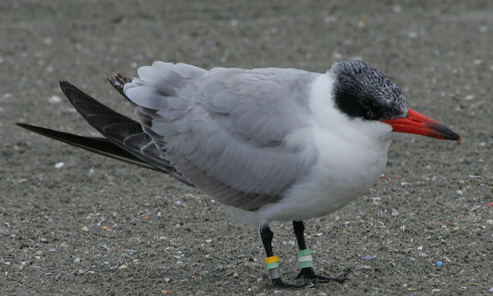 |
|---|---|
Willet with colored leg bands, (c) Don DesJardin |
Caspian Tern with colored leg bands--(c) Steven Smith |
Colored leg bands can be coordinated internationally between the United States and Canada, or only locally depending on the species. Colored leg bands on waterfowl are usually hard plastic with etched codes that are coordinated much like collars, but are smaller and less visible on the bird. Peregrine Falcons and Eagles also have colored leg bands with engraved codes.
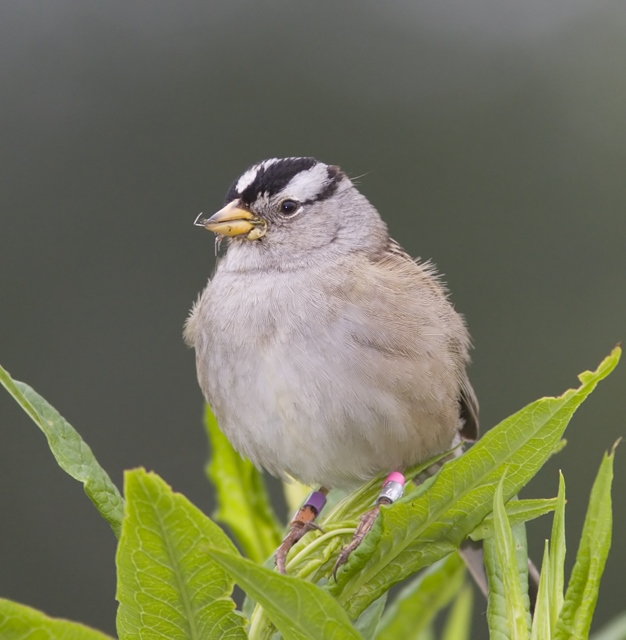
White-crowned Sparrow (c) Bill Ferensen
Colored leg bands for small birds are made of plastic and come in a variety
of colors that give unique combinations because of their placement on
the bird. Colored bands are sometimes placed on the upper leg as well
as the lower leg. The exact placement of the bands (above or below the "knee",
left or right leg), colors of bands, and location of the metal Service
band are all important in identifying color banded birds. Some birds,
notably shorebirds, may have flags and color bands mixed together on the same
bird. A flag is a leg band with tabs that extend away from the leg.
This flag identifies the country of banding for shorebirds under the
Pan American Shorebird Program.
![]()
Web tags are small markers of metal with a code (usually one or more letters) identifying the bander on one side and a number indicating the individual bird. The tags were developed to mark fingerling fish and have been adopted by bird banders for use on waterfowl chicks. Web tags may identify the local area or nest site of the bird, or be part of a study on chick growth and survival. The use of web tags allows individual marking of birds that were too small to band. Because web tags are used on chicks, they are the only auxiliary marker that is allowed to be used without banding the bird with a federally numbered band without special permissions. If the bird is later trapped and is large enough for banding, the band is added to the bird at that time. Web tags can allow banders to be more precise in their age determinations that might be possible using the birds physical appearance alone, as the tag will indicate the exact year hatched.
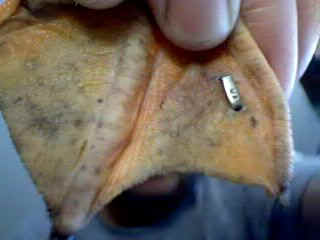
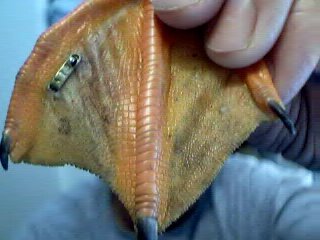
Mallard Web Tag -- Steve Guest photo
North American banders are also using a clay or plasticine-filled band on waterfowl. These clay-filled bands are similar to lock-on bands but the bands are oval and the inside of the band is filled with clay at banding. As the duckling grows, wear removes small amounts of clay until the duck has worn all of the clay out of the band, which results in a duck with a full-size band on a well grown leg. These bands are made with a federal band number on them , although they formerly used codes similar to web tags. These bands are currently being used on several species of ducks in North America.
Radio transmitters the allow tracking of individual birds movements, over short or long distances. Satellite transmitters can be tracked across the globe by satellites, and allow study of the migration or movements of a single bird around the world. Radios may be attached to a bird by many methods, including gluing the transmitter to a tail feather on a raptor or a neck collar for a goose, attaching it to the bird with a harness or glue, and even internal placement. Banders usually appreciate the return of radio transmitters as they can often be reused by the bander after replacement of the battery.
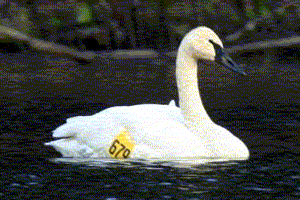
Trumpeter Swan with patagial tag -- Wayne Miller photo
Patagial Markers are shapes of vinyl (often circles) or cattle ear tags (square with codes) attached over the leading edge (or patagium) of the wing. These markers are very visible both in flight and on perched birds, although part of the marker may be obscured by feathers on a perched bird. Homemade markers may be any shape and may include multiple colors. Codes of letters and numbers are usually painted or sewn onto the marker. Commercial cattle ear tags are plastic with codes of letters and numbers. Cattle and sheep ear tags are sometimes used as patagial tags on birds.
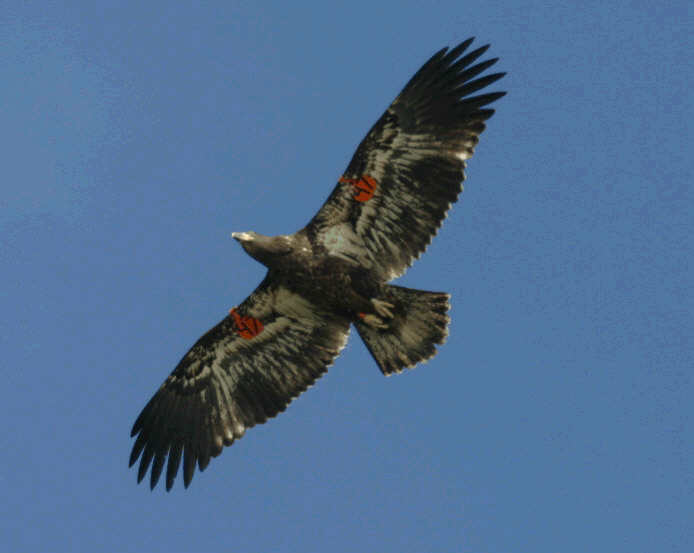
Bald Eagle with Orange Patagial Marker, (c) Steve Wagener of Wag the Dog Productions, Ltd.
The vast majority of patagial tags have codes, and the individual bird can often be identified by the code. Often, a partial code is reported, or only a marker with the color. This information is still of use as it can identify the research project. Look for patagial markers on vultures, eagles, swans, ravens, crows, and herons.
Tail streamers are pieces of tape that are folded over a tail feather and project out an inch or two from the end of the feather. The color of the marker and the shape of the tip (notched, pointed, squared) are useful information. These markers are often used in projects with migrant birds, and a cohort mark is typically used (all birds from one day get a red streamer on the left side of the tail with a notch in end of the tape, for example). Even though the individual bird can't be identified, the information is still of use to the bander. Tail streamers are used on birds from hawks to sparrows.